At Ohio University, Students and Teachers Turn Pollution Into Paint to Save Sunday Creek


Art professor John Sabraw of Ohio University paints with pigment made from pollution in Sunday Creek.
In Ohio, over 1,000 miles of rivers, streams, and underground waterways are polluted by millions of gallons of acidic water carrying heavy metals it picked up in abandoned coal mines. The toxic discharge, called acid mine drainage, is so ingrained into the life of the region that schoolchildren often reach for an orange crayon to draw a picture of a river.
Acid mine drainage is created when a chemical reaction sparked by water and rocks that contain sulfur makes sulfuric acid. That acidic water can leech heavy metals from surrounding rock, particularly when it runs through old coal mines, resulting in a highly toxic substance that flows into streams and rivers, turning them yellow, orange, brown and red as the metals oxidize.
The largest occurrence of this in Ohio is the Truetown Drainage, which dumps over 2 million pounds of iron oxide into nearby Sunday Creek each year, destroying seven miles of aquatic habitat.
“It is like junking a couple of cars in the stream every single day,” said John Sabraw, an environmental activist and professor of art at Ohio University, who is using paint to help combat the problem.
When Sabraw first moved to southeastern Ohio, he was struck by the sight of the multicolored streams devoid of aquatic life. He knew iron oxide could be ground into a fine powder to make pigment, which is used to color paint, so he wanted to use the supply in the river to make his own.
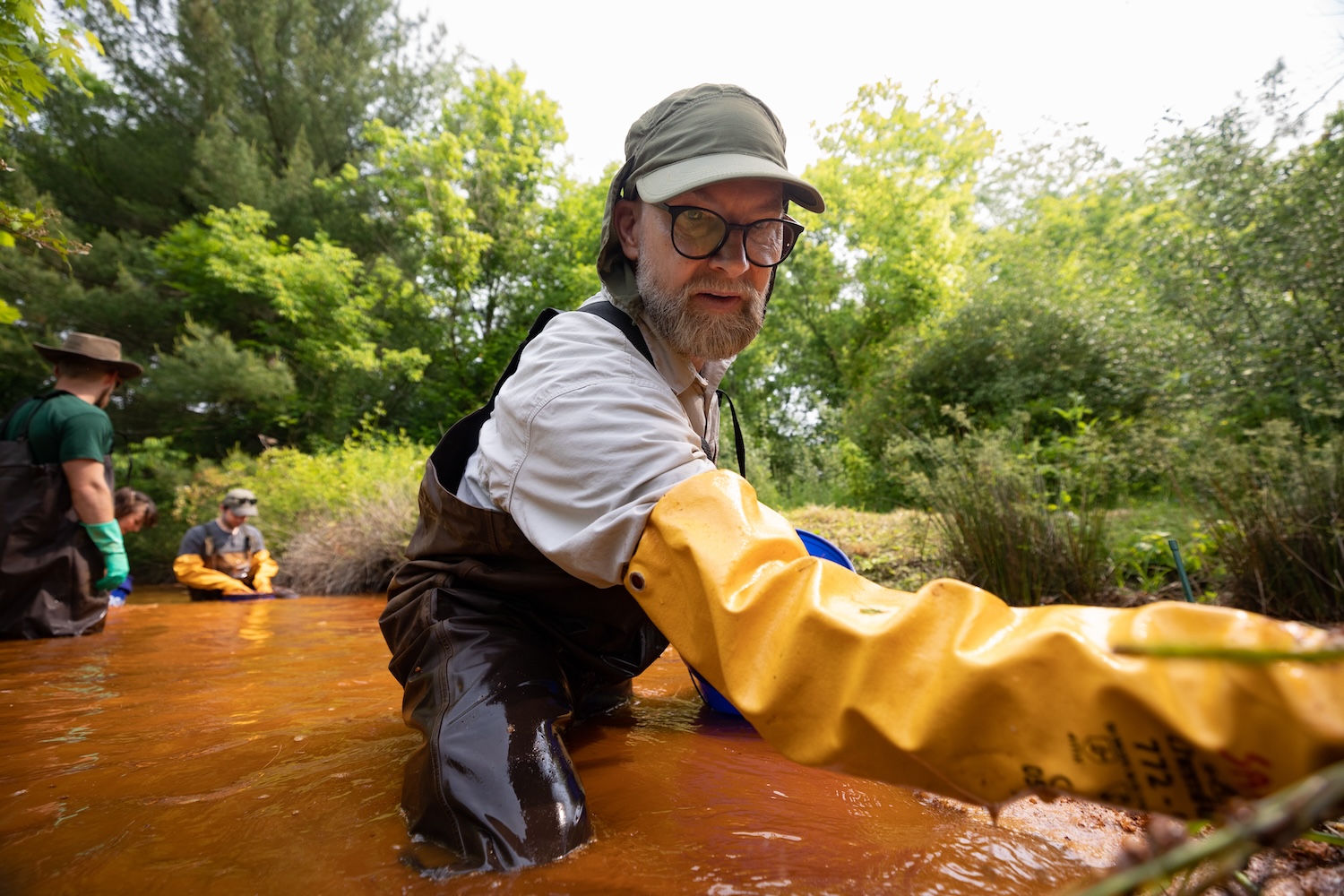
Turns out, another professor at the university — Guy Riefler from the civil engineering department — was trying to do the same thing. Now, they are both part of a team capturing the acid mine drainage, converting the extracted minerals into pigments for paint, and using the proceeds from pigment sales to fund watershed restoration projects and maintenance through a new social enterprise called True Pigments.
The team organized volunteers for a pilot effort to extract iron oxide from a section of Sunday Creek near the Truetown Discharge. They donned waders, scooped sludge from the creek bottom, tested the quality of pigment made with the minerals, and conducted experiments to refine the product.
Meanwhile, teams of art and engineering students from Ohio University worked on important aspects of what will soon be a pigment production plant, including pricing and sourcing materials, and how to build it, Sabraw said. These efforts are the focus of a short film, “Toxic Art,” produced by the environmental advocacy platform Rivers Are Life.
The team is building a new facility, called the True Pigment Acid Mine Drainage Treatment and Pigment Production Facility, at the abandoned mine site to capture and treat the acidic runoff before it reaches Sunday Creek. The iron oxide will be separated and processed there to create pigment products.
The pigment can be sold to offset operational costs, produce a small profit, and create jobs while stopping a perpetual source of pollution and restoring the creek for aquatic life, Sabraw said.

This same extraction process won’t work everywhere, but in some cases, it can be adapted based on the local chemistry of a particular site, Sabraw said.
“Each location affected by pollution in their waterways will have to analyze their chemistry and then adapt our process to effectively treat it,” Sabraw said. “Wherever a water pollutant contains components that might be able to be turned into a viable product in a particular market, our process may prove useful.”
Ohio University, the nonprofit Rural Action, the Ohio Department of Natural Resources, and the U.S. Office of Surface Mining Reclamation and Enforcement are also a part of the project.
“The university and the state and federal agencies bring expertise and a lot of resources, but it’s much easier for us to do things like purchase the Truetown property and establish a business to sell pigment,” said Michelle Shively MacIver, director of project development for True Pigments. “Through our collaboration, we’ve been able to secure funding from local foundations and our state and federal partners. Rural Action does a lot of the community outreach and education surrounding our work, which is more in our wheelhouse than our partners'."

The new production facility is expected to be in full operation in 2025, and that seven-mile stretch of Sunday Creek will begin to recover as a result, MacIver said.
“This is the big ‘why’ of this project,” MacIver said. “None of us set out trying to make paint — well, maybe John did. We’re just trying to clean up this stream that flows through our home place and bring it back to life.”
Images courtesy of Ohio University
Construction Workers Are Invaluable To The Clean Energy Transition: Let’s Treat Them Like It
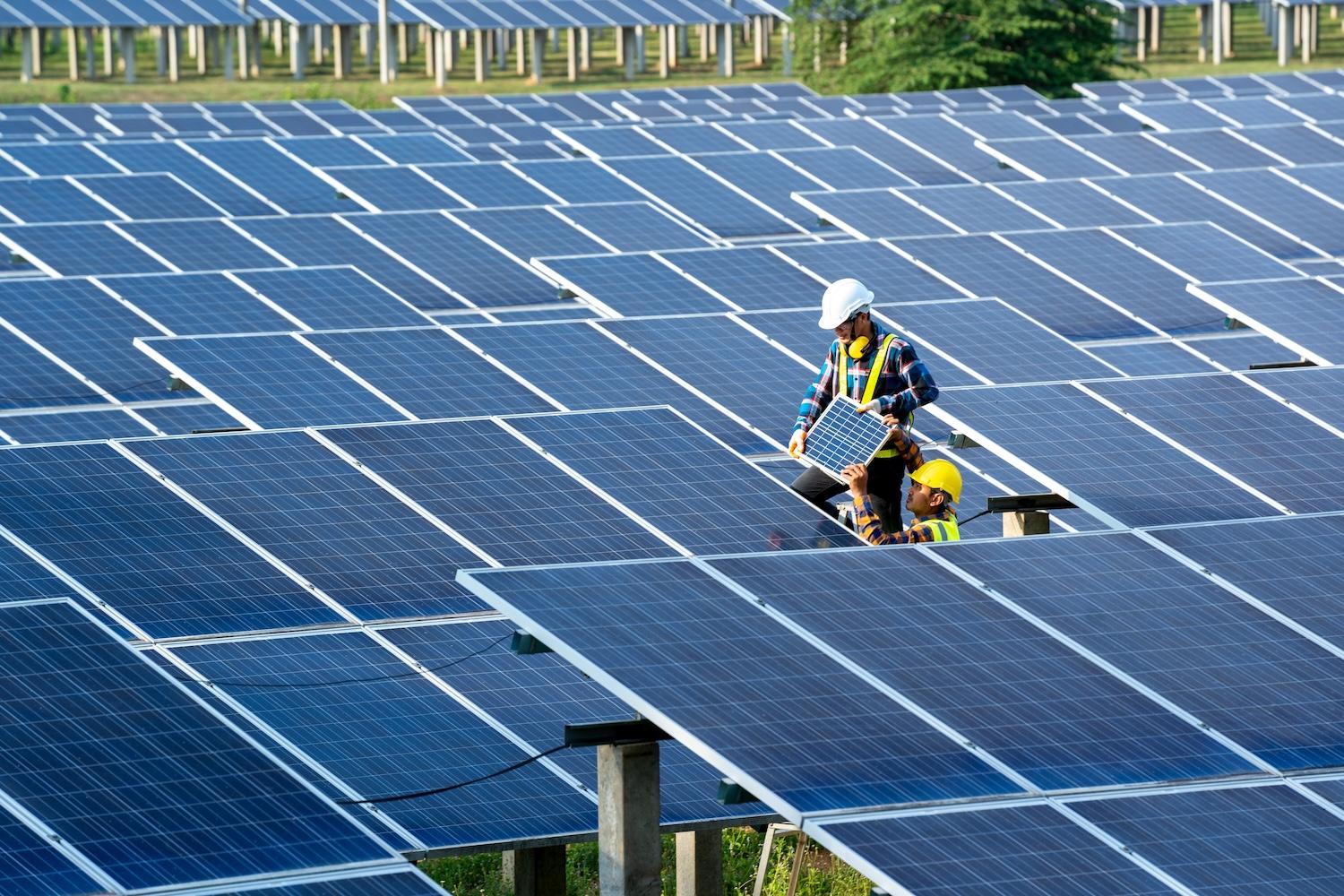

(Image: visoot/Adobe Stock)
Covering fair labor for clean energy construction workers, this story is part of From the Frontline, a guest-contributed column where we hear directly from those who are impacted by climate change and fighting for action. If you're interested in contributing your perspective to this column, please get in touch with us here.
Clean energy jobs are growing by the millions worldwide, showing that climate action can deliver on its promise of economic co-benefits. Unfortunately, we don’t have enough skilled workers to meet demand for a critical field. While nearly half of the workforce needed to meet 2030 decarbonization goals are in construction, more than 92 percent of U.S. electric power generation companies currently struggle to find construction employees.
This isn’t just a U.S. problem either. According to the latest World Energy Employment Report, it’s a global challenge. Construction workers are key to realizing our vision for a sustainable future. How can we honor their value and ensure a skilled and fulfilled workforce?
Casting a wide and inclusive net to meet demand for clean energy construction workers
Clean energy construction requires specialized training in areas like electrical work and wind turbine installation. Breaking down barriers to learning these skills is a necessary first step. Paid apprenticeships — now incentivized through tax credits in the U.S. — allow trainees to gain skills while getting paid. Childcare and transportation vouchers can also make a huge difference for working parents or individuals without reliable transportation. Since skills from the fossil fuel industry are transferable to clean energy, tapping into this workforce benefits employers and provides a transition pathway for workers at risk of job losses.
A wide net also includes making space for historically marginalized communities. Re-entry programs like Homeboy Industries' Solar Panel Training Program provide a second chance for individuals transitioning from the criminal justice system who may otherwise have difficulty finding employment. In the U.S., women and Black workers are underrepresented across well-paying careers like wind turbine technicians and solar installers. Targeted and paid efforts like Solar Energy International’s Women in Solar Program can be applied internationally based on local diversity opportunities.
Green construction as a quality career path
Inclusive training and recruitment alone won’t solve labor shortages. Diverse workers should have access to progressive careers in construction, yet there are existing gaps. For example, while over 30 percent of clean energy construction laborers are Latinx, this lowers to 10 percent for construction managers. Employers will need to intentionally identify and correct these types of disparities.
Building a strong reputation means ensuring family-sustaining benefits and dignified working conditions. Globally, construction worker compensation can vary by a factor of up to 20, and wages in the renewable energy sector lag behind the fossil fuel industry by about 38 percent.
Following international guidelines like the Anker Methodology for a Living Wage ensures workers are fairly and competitively compensated, no matter where they live. If we truly respect the value of these workers, though, we can’t stop there. Coupling fair wages with additional benefits like paid time off, employer-sponsored healthcare, workers’ compensation insurance, and savings can enhance job quality and reduce costly turnover.
While blanket worker protections may have good intentions, marginalized workers like migrants are disproportionately vulnerable to exploitation and need targeted protections.
In the U.K., 1 in 3 migrant construction workers have worked for no pay. In oil-rich Gulf Cooperation Council countries like Qatar, Saudi Arabia and the United Arab Emirates, migrant workers face initial debts from recruitment fees and late payments. The Employer Pays Principle, which notes that no worker should pay to get a new job, was developed as a response to unfair recruitment fees for migrants. In the U.S., rates of injury or death are disproportionately higher in Latinx construction workers, many of whom are migrants.
Culturally competent training in different languages ensures that all workers are well-versed in safety and health protections, their legal rights, available grievance mechanisms, and procedures for remedy.
Ironically, the labor needed to address climate change is also threatened by its very existence. Outdoor workers face disproportionate risk from unprecedented heat waves and wildfire smoke. Since global workplace protections vary, employers must implement proactive, mandatory outdoor safety standards, especially in regions prone to extreme weather. Recommended standards include proper acclimatization, mandatory water breaks, protective gear, training on symptoms of heat-related illness, and paid time off when conditions are deemed high risk.
Honoring workers by pledging accountability
Unions have a documented positive impact on labor conditions, but they’re not the only pathway for strong commitments. Mechanisms like Community Workforce and Project Labor Agreements provide mutually agreed-upon benefits and protections for union and non-union workers alike. Strong policies and ongoing due diligence are necessary to maintain accountability. Dedicated employers can advocate for high labor standards across their supply chain by requiring contractors and subcontractors to follow in their steps.
This issue is deeply personal to me. I come from a family of Mexican immigrants who moved to the U.S. in search of a better life. As a child, I lost my 26-year-old uncle to a construction site accident. He was working temporarily in the U.S. to support his newborn son. He deserved more protection than he was granted.
The industry should understand that the movement is not just about mitigating climate change — it’s about our moral imperative to protect people along with our planet. Our victory depends on construction workers. Why not treat them like they deserve?
This Kenyan Startup Aims to Get More Electric Motorcycles on the Road


A motorcycle taxi (known as a "boda boda") in rural Kenya. (Image: Amdanykip/Wikimedia Commons)
Electric vehicles are key to decarbonizing road transport, a sector that accounts for around a sixth of global emissions. Kenya’s President William Ruto has an ambition to achieve 100 percent renewable power by 2030, and adopting low-carbon and efficient electric mobility systems will play a significant role.
Aiming for 5 percent of all registered vehicles to be electric-powered by 2030, Ruto set a target to have 200,000 electric motorcycles across Kenya before 2025. That’s compared to around 1,350 electric-powered vehicles on Kenyan roads today, with motorbikes accounting for 62 percent of those, according to a 2023 survey.
“The capital expenditure required to implement such large-scale adoption of electric vehicles is very high, so the question is: Where would the financing come from?” said Sebastian Mwaura, co-founder and CEO of the social enterprise YNA Kenya. The early-stage electric vehicle company is one of two winners of the U.N. Global Climate Action Awards announced at the COP28 climate talks last week.
Financing mechanisms for scaling up clean energy investment in emerging economies were center stage at COP28. Africa, a developing continent home to 540 million people, is warming faster than the rest of the world, despite being responsible for a small fraction of global carbon emissions. Yet Africa received just 2 percent of global investments in renewable energy over the last two decades.
Ironically, the continent also holds more than half the raw materials needed to decarbonize global economies. It has 60 percent of the best solar resources globally, yet only 1 percent of installed solar photovoltaic capacity, for example.
Crises like the 2008 financial crisis and the COVID-19 pandemic limited Africa’s economic growth while its debt continued to rise at a rate four times higher than its gross domestic product, hitting $1.8 trillion in 2022, according to the United Nations Conference on Trade and Development. Largely due to the rate at which its debt is rising, financing an energy transition or contributing to climate change solutions is practically impossible for Africa, a paradox that needs attention on a global level.
YNA Kenya aims to find a solution that doesn’t rely on global aid. “We believe the financing solution for our enterprise is embracing Web3 blockchain technology, where someone in New York or Dubai or anywhere in the world can invest in Kenya,” Mwaura said. Web3 refers to the prospect of a new iteration of the internet based on blockchain, the digital ledger technology that creates an inalterable, secure record of transactions best known for cryptocurrencies like Bitcoin.
To finance their startup, the YNA Kenya team created a carbon credit trading platform using blockchain, where companies can buy carbon credits to offset their emissions and investors can finance YNA Kenya by buying bulk carbon credits in advance at a lower price and then selling them at a profit.
“We have created a system where you will be able to buy carbon credits generated by electric motorcycles,” Mwaura said. Onboard devices will track miles traveled by YNA Kenya’s e-cycles, so they only generate carbon credits when they’re in motion. “The data is posted on the blockchain platform, whereby you cannot edit or tamper with it, and it is traceable,” Mwaura explained.
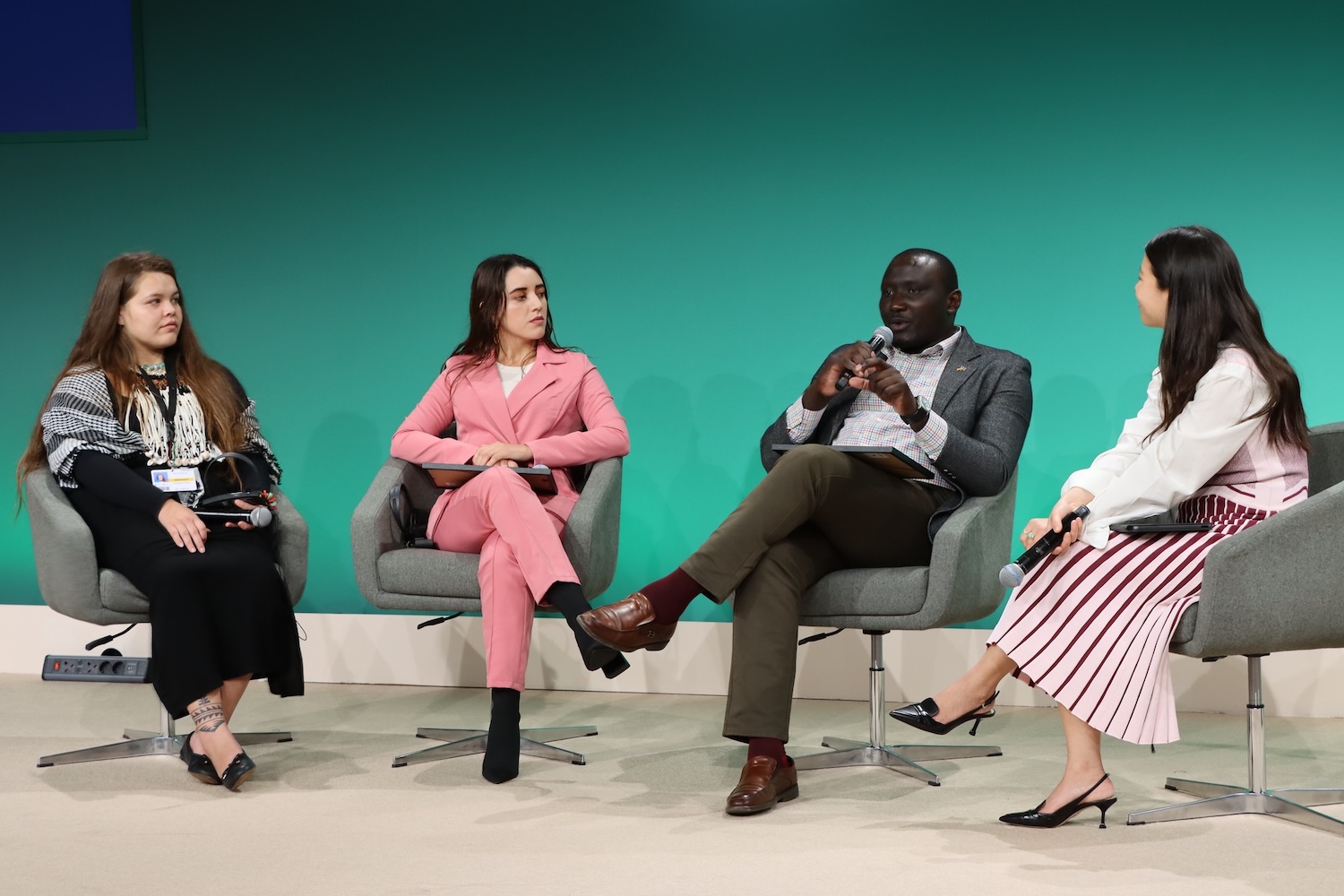
Carbon credits have proven useful for mobilizing and directing capital into projects that promote the transition to net-zero emissions. However, having trustworthy and accurately monitored carbon credit data remains a challenge. While blockchain technology does offer potential to enhance transparency in carbon markets, it’s criticized because it is a fledgling system, it consumes a lot of energy, and it is difficult to integrate into central regulatory bodies.
Still, the startup already has backing and barter technology deals with Microsoft and Google. And it's seeking further investment to integrate its carbon market blockchain platform with a payment provider to allow for seamless currency exchange, Mwaura said.
With that financing, YNA Kenya aims to bring 12,000 electric motorcycles onto the road over the next five years, which it estimates will save 64,800 metric tons of carbon dioxide equivalent. It has 20 bikes ready and plans to have 100 bikes at the start of next year.
“Beyond having a fleet on the road, over the next five to 10 years, we hope to plug the ... gadget to every electric motorcycle in Africa,” he said, referring to the onboard device that tracks e-bike miles. “Then we become the marketplace for the carbon credits, which will be huge as the adoption for the electric motorcycles comes on board.”
What’s more, the riders for the startup’s first round of electric motorcycles will be exclusively women. “We have 20 women already signed up, and everyone wants to meet them! But, to ensure their security, we will hide their information and credentials,” Mwaura said.
This is part of YNA Kenya’s Her Go program that aims to integrate women into the e-mobility sector. By mid-century, it is predicted that climate change could push up to 158 million more women and girls into poverty globally. The COP28 gender agenda calls for increased finance flows to women in regions most impacted by climate change.
YNA Kenya is also rolling out solar-powered, battery-swapping stations that will provide renewable energy for charging electric vehicles, reduce reliance on non-renewable energy sources, and build the resilience of Kenya’s EV charging infrastructure.
The United Nations Framework Convention on Climate Change (UNFCCC) has spearheaded the U.N. Global Climate Action Awards since 2011. This year, it saw applicants from 120 countries for projects that make communities more sustainable, resilient and equitable.
The 2023 awards are in partnership with the International Renewable Energy Agency (IRENA), the International Union for Conservation of Nature (IUCN) and the Permanent Representative of the United Arab Emirates to IRENA.
After COP28, Where Does the Fight Against Climate Change Go From Here?


Delegates including U.S. climate envoy John Kerry (center) look on as the final agreement text is announced at the COP28 climate talks on Wednesday. (Image: COP28 UAE/Flickr)
For the first time in almost three decades of United Nations climate talks, the central outcome of this year’s session (COP28) includes an agreement to transition the world away from fossil fuels.
Around 85,000 participants attended COP28 to discuss the state of the climate crisis and negotiate how to limit global temperature rise to 1.5 degrees Celsius above pre-industrial levels. Everyone was watching one particular sentence in the COP28 text. The final version calls for “transitioning away from fossil fuels in energy systems, in a just, orderly and equitable manner, accelerating action in this critical decade, so as to achieve net zero by 2050.”
Amidst strong pushback from oil-rich nations against language they said attacked any source of non-renewable energy and their push for a focus on emissions rather than fuels, some have called this consensus a historic milestone. But how a just, orderly and equitable energy transition will be financed remains an unanswered question.
The transition away from fossil fuels
More than 80 countries came into COP28 saying they supported a global agreement to "phase out" fossil fuels. This language wasn’t included in the final text, leading to disappointment among many. Oxfam International, an organization focused on alleviating global poverty, for example, called the outcome “grossly inadequate.”
But the final text still fosters hope for others. “The Earth is down but not out, as countries agree to transition away from fossil fuels, but fall short of consensus on the full phase-out of coal, oil and gas at COP28,” said Manuel Pulgar-Vidal, global climate and energy lead for the World Wildlife Fund (WWF), who served as president of the COP20 climate talks in Lima, Peru. “After three decades of U.N. climate negotiations, countries have at last shifted the focus to the polluting fossil fuels driving the climate crisis. This outcome must signal the beginning of the end for the fossil fuel era.”
The agreement completes the first Global Stocktake, an assessment done every five years to evaluate the world's progress in achieving the climate goals set in the 2015 Paris Agreement. The next step is for countries to include the outcomes in their own climate policies — specifically their greenhouse gas commitments under the Paris Agreement, formally known as nationally determined contributions or NDCs, which are also updated every five years. These will be presented in Berlin in 2025 and subject to scrutiny.
The agreement also included targets to triple renewable energy generation and double energy efficiency by 2030. “The inclusion of tripling renewables in the final COP28 text is unprecedented and signals the start of a massive clean energy revolution,” said Bruce Douglas, CEO of the Global Renewables Alliance. “It is the first time all nations have recognized renewable energy as the main solution to the climate crisis, representing a paradigm shift in the energy transition.”
Yet the final text was missing input from the Alliance of Small Island States, which didn’t make it to the room on time, according to a public statement it released on Wednesday. The alliance represents 39 small island developing states that are among the most at risk from climate change globally. They called for stronger language around a fossil fuel phase-out, with the statement reading: "We do not see any commitment or even an invitation for [countries] to peak emissions by 2025." But whether their presence would have changed the agreement by any significant measure is unlikely, said David Waskow, director of the World Resources Institute’s (WRI) International Climate Initiative.
Climate finance: Where will the money come from?
In total, $4.3 trillion in annual climate-related finance flows are needed by 2030 to avoid the worst impacts of the climate crisis, according to the U.N. Where the financing to facilitate the energy transition away from fossil fuels will come from remains a big question.
“The agreement itself is not the highest or most ambitious outcome that we could have got out of the scope, because it does not address the finance package that is needed in order to help developing countries make the transition,” said Jamal Srouji, an associate in the WRI global climate program. “But it is a step forward and will be an important discussion at COP29.”
By 2030, $100 billion a year will be needed to address losses and damages caused by climate change. On day one of COP28, parties pledged $792 million toward the Loss and Damage Fund to support the countries most vulnerable to and impacted by climate change.
“Finance is key to unlocking climate action,” said Stephen Cornelius, the deputy global climate and energy lead at WWF. “The many pledges we have heard at COP28, while welcome, are a drop in the ocean compared to what is needed. The funding pot will now need to grow by orders of magnitude to adequately help people in harm's way. The need for loss and damage and adaptation funding will only continue to rise rapidly if countries do not invest more in cutting emissions and phasing out polluting fossil fuels.”
COP28 reiterated the call for high-income countries to at least double their 2019 adaptation finance commitments by 2025. Some estimate this will only amount to $40 billion.
“Developing countries, and the poorest communities, are left facing more debt [and] worsening inequality with less help and more danger and hunger and deprivation,” said Nafkote Dabi, Oxfam International’s climate change policy lead.“COP28 was miles away from the historic and ambitious outcome that was promised.”
Unabated emissions, nature-based solutions, and carbon capture and storage dominate the conversation at COP28
The COP28 agreement urges countries to accelerate their phase-down of unabated coal power — meaning coal power with emissions that are not offset by something like carbon capture — and “substantially reduce non-carbon dioxide emissions, including methane emissions, by 2030.” However, the text still “recognizes that transitional fuels can play a role in facilitating the energy transition,” allowing the continued use of fuels like natural gas.
“It is unfortunate that with the inclusion of the word ‘unabated’, the outcome suggests there is a considerable role for dangerous distractions such as large-scale carbon capture and storage and ‘transitional fuels,’” said Pulgar-Vidal of WWF. “This is not the case. For a livable planet, we need a full phase-out of all fossil fuels.”
There is much debate around carbon capture and storage technologies, especially when fought for by the oil industry. The final stocktake text doesn’t put strict guardrails on the use of carbon capture and storage, Srouji from WRI said. “This technology should be limited to hard-to-abate sectors and not be used as an argument to further delay the transition toward cleaner energy sources,” he added.
In conjunction with the discussion of nature-based solutions at COP28, the text also “encourages the implementation of integrated, multi-sectoral solutions, such as land use management, sustainable agriculture, resilient food systems, nature-based solutions and ecosystem-based approaches” to protect, conserve and restore nature and ecosystems. But not all countries are taking that recommendation.
“Along with phasing out fossil fuels, nature is integral to effective climate action,” said Fernanda Carvalho, the global climate and energy policy lead at WWF. "It is disappointing to see countries not including the recommendation … to protect 30 to 50 percent of all ecosystems."
Looking toward COP29 in Azerbaijan
The next two years are critical to follow through with the negotiations agreed upon at COP28. Azerbaijan will host COP29 in November 2024, and Brazil will host COP30 in November 2025. The hope is that the scale-up of financing will be addressed at next year's talks, where setting a new collective goal on climate finance will be central to the conference.
How Estée Lauder Blew Past Its Supplier Diversity Goals
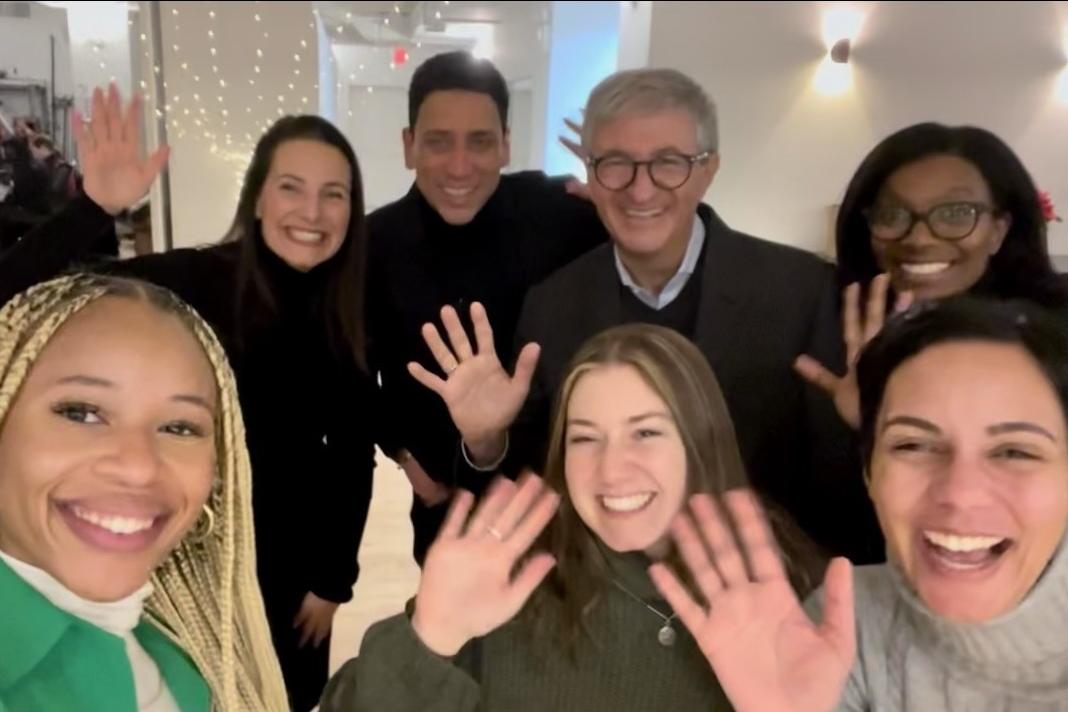

Leadership at Estée Lauder Companies strike a pose with Alberto Ruiz (back, second from left), co-owner and president of the design and media firm CVLT|Urban Studio, and his team. (Image courtesy of Estée Lauder Companies)
Estée Lauder Companies has already surpassed its 2025 goals to spend more with Black- and women-owned businesses.
As supplier diversity rises to the top of corporate agendas, nine out of 10 companies expect to maintain or increase their support for it, according to 2023 polling. This acknowledges the growing recognition among businesses that promoting diversity, equity and inclusion in supply chains not only aligns with values, but also boosts innovation, competitiveness and long-term sustainability.
For companies that are falling short of their supplier diversity goals, it can be illuminating to look at how a business like Estée Lauder Companies — which owns brands like Estée Lauder, Aveda, Clinique and Smashbox — approached the challenge, exceeded its goals and continues to raise the bar.
“We believe that an inclusive and diverse supply network will help to stimulate economic growth within the communities where we live, work and source," said Mindi DeLeary, vice president of responsible sourcing for Estée Lauder Companies. “We think that it will create more jobs, support those communities and will also drive more innovation and competition in the marketplace. There’s also a strong business play, an advantage for us as a company in terms of bringing in diversity of ideas and diversity of solutions.”
The company spent $44 million with Black-owned businesses in 2023, a 120 percent increase over 2020, and spent $162 million with women-owned businesses, according to its latest Social Impact and Sustainability Report. Achieving these results grew out of a strategic approach to embed diversity, equity and inclusion (DEI) across the business, DeLeary said. That includes establishing the infrastructure to capture, measure and build on progress, and maintaining a steady and high-quality pipeline of diverse suppliers through collaboration with supplier diversity organizations and its industry peers.
Making supplier diversity a company-wide commitment
The emphasis on supplier diversity at Estée Lauder Companies starts at the top, with its racial equity steering committee and gender equity task force, both with representation by senior leaders in the company. The company also educates its supply chain and research and development teams about supplier diversity through the Value Chain Conscious Inclusion Program.
“Our partnership with executive leaders across the company and their full buy-in and support has enabled us to make and exceed our public commitments in the space, driving more transparency and accountability,” DeLeary said.
Supplier diversity is fully integrated into the company’s Global Procurement strategy. Yet its brands, regions and functions have the flexibility to create their own supplier diversity goals and initiatives,leveraging toolkits from the company to help identify an inclusive cross-section of suppliers.
A steady stream of educational and awareness-raising activities also keeps the conversation centered on supplier diversity, including regular spotlights on diverse suppliers on the company intranet.
“It's important that we create that culture from a decision-maker perspective, so that every employee can actively contribute to growing diverse and small suppliers,” said Ashley Gabb, the company’s director of supplier inclusion and diversity. “The spotlight series on our diverse suppliers, for example, raises awareness of who is in our supply base and gets folks to reach out to us to learn more.”
She and her team also partner with key decision-makers across the company around supplier diversity goals they can implement as part of their everyday work. For example, Gabb’s team worked with the senior vice president for the North America supply chain to set up a strategy for increasing the diversity of transportation and logistics suppliers, including matchmaking sessions with new diverse suppliers.
The company also partners with its employee resource groups (ERGs) to expand supplier diversity. During Black History Month in 2023, it partnered with the New York-New Jersey Minority Supplier Development Council and its Black employee resource group, NOBLE, to discuss how minority-owned suppliers can gain access to opportunities at the company.
All of these efforts have “created this pull where now we have people from brands and functions and regions reaching out, asking how they can participate,” DeLeary said. “And for the procurement, the emphasis on diversity has helped align everybody to the vision and understanding that it's not just about the best cost or the best quality or the most innovation, but also about sustainability and supplier inclusion and diversity. This isn't the procurement of 20 years ago that was just about driving cost. We're really focused on creating value within the business.”
A solid foundation to build and capture progress
Another contributing factor to success at Estée Lauder Companies is the Supplier Inclusion and Diversity registration portal launched in 2022, where prospective diverse or small businesses can register to be included in the company’s database of potential suppliers.
The portal is a way to not only look at increasing spend but also growing the number of diverse suppliers in the company’s supply base year over year, Gabb said. “We want to ensure we are including suppliers in new opportunities and exposing them to new parts of the business, so they can work with other brands, regions and functions within the company.”
As a result, Estée Lauder Companies now has diverse suppliers and small businesses across all categories in procurement, Gabb added. “They're very much a part of the way we work and how we create our products,” she said “We see the firsthand benefit of it, and a lot of our suppliers have been with us for a very long time.”
Beyond the benefit for individual small businesses, partnering with suppliers that are often overlooked by large companies also benefits communities and society at large. “When we include diverse suppliers, there is a societal impact. When we're working with them, our diverse suppliers end up growing their business, and their employees end up growing the communities that they live in,” Gabb said. “ “Another unique component of our program is that we don’t just look at our spend with diverse suppliers, but we also work with some of our non-diverse suppliers to make sure that they're also subcontracting to diverse suppliers. That has a ripple effect on the economy.”
Partnering to maintain a flow of diverse suppliers
These supplier diversity efforts are going international. That includes a partnership with Minority Supplier Development U.K. (MSDUK), the country’s leading supplier diversity advocacy organization, to increase spend with small and diverse businesses. And in 2023, it partnered with WeConnect International, a global network that connects women-owned businesses to qualified buyers, to train the procurement teams in Germany, Switzerland and France.
“Partnering regionally is very important because we can go to our partners to share out opportunities,” Gabb said “They'll tell us who's a great fit, give us any recommendations, and that additionally helps us grow the spend on diverse suppliers.”
Overcoming challenges
Sometimes the company’s Supplier Diversity team is challenged to overcome employee misconceptions about the capabilities and costs of working with diverse suppliers. They might assume, for example, that working with diverse suppliers is more costly or could mean sacrificing quality or innovation, Gabb said.
When those concerns arise, “We make it clear that we select our diverse suppliers based on them being qualified and able to provide innovation and competitive solutions. There’s no cost there,” Gabb said. “Sometimes there is a misconception, too, that all diverse suppliers are small businesses. We work with very large, multinational, diverse-owned businesses, so we always want to tell that story. That is why having conversations heralding the work of diverse suppliers, sharing their capabilities, creating matchmaking sessions, and raising awareness is so important.”
While interest in supplier diversity has grown markedly over the past three years, diverse spend remains highly concentrated: 80 percent of companies have less than 5 percent of their purchases with diverse suppliers, according to a 2023 report. A high concentration of spend with a smaller number of suppliers represents a risk to businesses, the report noted. If there is concentration of spend with a few suppliers, industries may miss the opportunity to develop new suppliers and have a bigger impact.
For Estée Lauder Companies, a key to success has been avoiding precisely that risk, Gabb said. It consciously cast its net far and wide, involving everyone in the shared goal of supplier diversity — from top leadership, to employees, to advocacy organizations that can support a pipeline of diverse suppliers — all of which has been instrumental in achieving its supplier diversity goals.
The $17 Billion Price Tag on Sustainability in the Financial Sector


(Image: Tech Daily/Unsplash)
We all know changing financial providers can be a hassle. But more and more Americans are braving the paperwork and dreaded time on hold with customer service to move from one bank, insurer or pension provider to another. One of the reasons why might surprise you. While cost and returns remain key, for a growing cohort of consumers there’s a new reason to switch brands: sustainability.
More than half of U.S. consumers think it’s “important” or “very important” for financial service providers to act responsibly when it comes to society and the environment. And they're voting with their wallets. Banks, general insurers and pension providers lost $17 billion in 2023 as consumers switched to industry competitors they perceived as more sustainable.
That’s according to an upcoming report from the research technology company Glow, in collaboration with TriplePundit, our parent company 3BL and panel partner Cint, that asked more than 3,000 U.S. consumers how sustainability impacted their purchase decisions across 12 industries. Glow combined the survey findings with other data and previous analyses to put a monetary value on the cost of consumers switching brands for sustainability reasons.
"Sustainability programs are often seen as discretionary, making it difficult for executive teams to commercially justify the ongoing investment when the economic backdrop becomes more challenging," said Tim Clover, CEO of Glow. "This report uses robust data to highlight the risks and opportunities of sustainability when consumer switching is taken into consideration."
More than 15 percent of survey respondents said they switched their bank, pension or insurance provider over the past 12 months because of their social or environmental behavior.
In each of these sectors, a third or more respondents said social and environmental considerations were either "a significant influence" or "the single most important reason" for choosing at least some of the financial services they use.
And that's only the start: Over half of consumers expect sustainability and social responsibility to have more impact on their choice of financial providers next year than they do today.
“Consumers are increasingly factoring social and environmental considerations into their purchase decisions," said Mike Johnston, managing director of data products at Glow. "This report highlights the cohorts that care and identifies the barriers preventing more consumers from choosing sustainable brands. It will help leading brands justify their efforts and those less developed identify areas of opportunity."
So, what’s motivating consumers to seek out other brands, how do they determine which brands are sustainable, and what type of sustainability messaging resonates most with them? We'll take a closer look in the Size of Prize Report, set to publish in January 2024. Click here to be updated when it's released.
Carbon Capture and Sequestration in the Spotlight at COP28
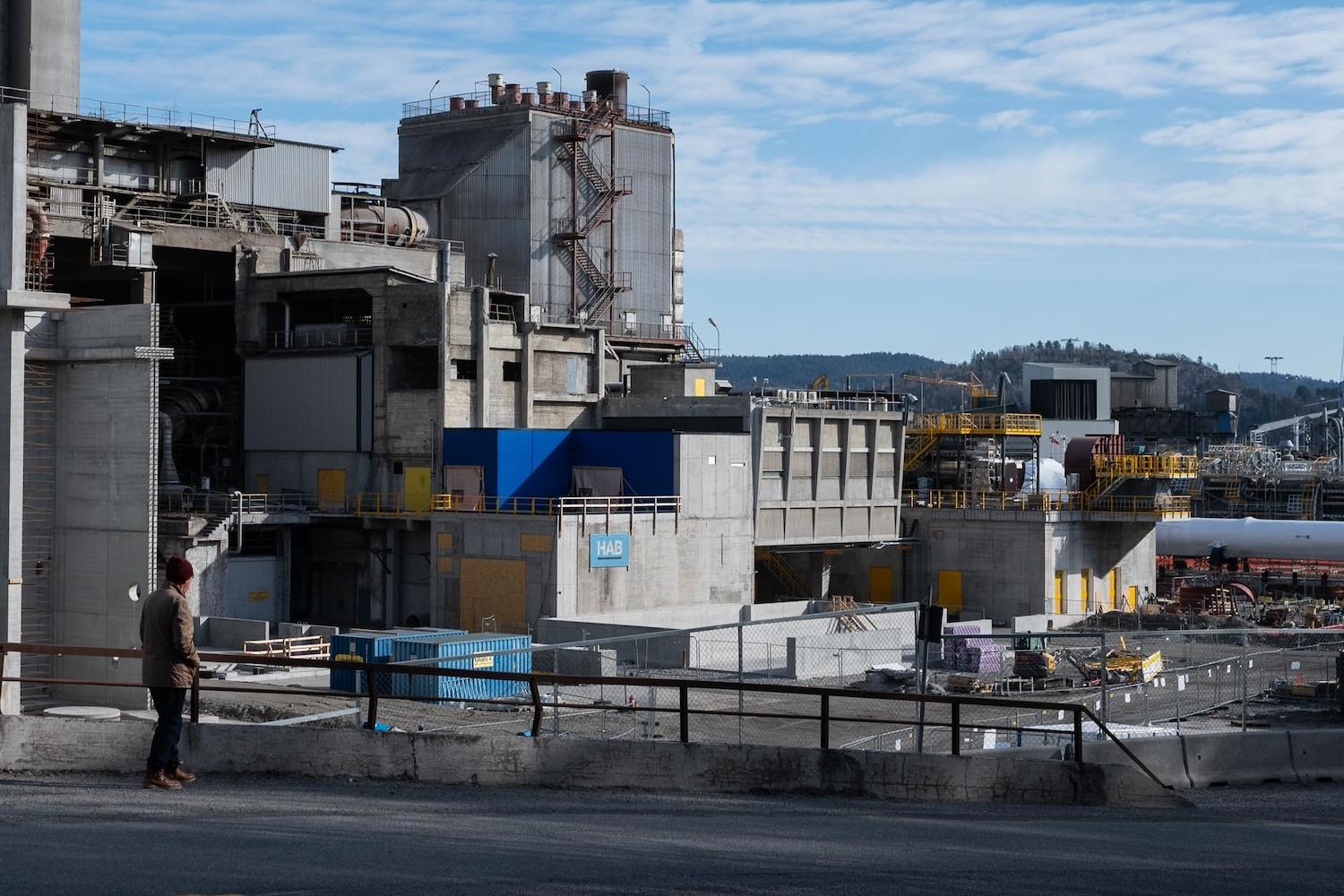

The HeidelbergCement Norcem plant in Brevik, Norway, became home to the world's first carbon capture system for the cement industry earlier this year. (Image: Astrid Westvang/Flickr)
The COP28 climate talks cast new attention on carbon capture and sequestration (CCS) strategies. Advocates point out that the Earth's natural sequestration systems are already overburdened, and some argue that large-scale, underground carbon sequestration facilities are needed to draw excess carbon dioxide from the air. However, their case is being undermined by others who advocate for new carbon sequestration technologies, including strategies that enhance the ability of nature to absorb excess carbon.
The case for carbon capture and sequestration
Advocates for carbon capture and sequestration point to the simplicity, scale, long duration and reliability of the technology. ExxonMobil, for example, describes CCS as systems to capture carbon dioxide that “otherwise would be released into the atmosphere, and injecting it into geologic formations deep underground for safe, secure and permanent storage.” The company further claims the technology is "readily available" and "can significantly reduce emissions from sectors like refining, chemicals, cement, steel and power generation."
That reference to “geologic formations” is a bit disingenuous, though. In North America, for example, captured carbon is likely to be injected underground for the purpose of extracting more oil from mature wells. On November 2, ExxonMobil increased its position in the enhanced oil extraction industry when it announced the acquisition of the firm Denbury.
The case against carbon capture and sequestration
Aside from its proven deployment in enhanced oil recovery, the case for carbon capture and sequestration is a shaky one on economic grounds. Critics argue that it is expensive compared to replacing fossil fuels with renewable resources. Instead of applying CCS to power plant emissions, they argue the technology should be reserved for heavy industries where the application of renewable energy is impractical.
A working paper published on December 4 by researchers at the Smith School of Enterprise and the Environment of Oxford University makes the economic case against carbon capture and sequestration for power plants. The authors note that the cost of CCS has not declined “at all” in 40 years, and it is not expected to decline significantly in the future.
That’s a sharp contrast with the cost of wind and solar power. Both plummeted in roughly the same period, and both are expected to continue declining in the coming years.
“Relying on mass deployment of CCS to facilitate high ongoing use of fossil fuels would cost society around a trillion dollars extra each year — it would be highly economically damaging,” said Rupert Way, honorary research associate at Smith.
Here in the U.S., the economic case against carbon capture for power plant emissions has been underscored by the FutureGen CCS project. Aimed at capturing and sequestering carbon emissions from a coal power plant in Illinois, FutureGen was announced in 2003 as a model for others to follow. The project was canceled in 2015 after private investors failed to match $1 billion in public funding. Plans to retrofit a coal power plant in New Mexico for CCS fell through after the plant closed in 2022.
Longstanding plans for a new carbon pipeline in the Midwest were withdrawn in September after opposition from residents and regulators. The pipeline would have transported carbon emissions from 30 ethanol plants to a central location in Illinois.
Making captured carbon irrelevant, eventually
In another wrinkle on the carbon capture issue, researchers at the Massachusetts Institute of Technology point out that conventional CCS systems at coal power plants are not designed to capture 100 percent of emissions. The goal of 90 percent has long been used as a technologically attainable and fiscally feasible benchmark. The researchers note that removing significantly more than 90 percent will require “a leap” to more expensive, energy-intensive technology.
Anything less than 100 percent capture would still enable high concentrations of carbon dioxide to escape into the atmosphere. In contrast, the technology for reducing power plant emissions by 100 percent is already at hand, in the form of wind, solar and other renewables.
The Smith researchers do foresee the need for carbon capture and sequestration to decarbonize heavy industries, including the very ones highlighted by ExxonMobil — with the exception of power plants, that is.
That may be necessary in the foreseeable future, but it could become irrelevant in the long run. New technologies that deploy renewable energy to decarbonize steel, cement making and other industries are already emerging.
The “green steel” movement, for example, deploys electric furnaces and green hydrogen produced from water and renewable energy instead of fossil fuels. The technology is supported by leading steel buyers including automotive stakeholders, as illustrated by Volvo and the Swedish green steel firm SSAB.
Two other industries mentioned by ExxonMobil, refining and chemicals, are also beginning to deploy green hydrogen as a replacement for captured carbon and other petrochemicals. One good example in this area is the ammonia industry, where the leading firm CF Industries is constructing the first carbon-free ammonia plant at commercial scale in North America.
The cement industry provides still another example. Innovators like Novacem are coming up with new formulas and deploying biofuels to develop cement with a carbon-negative profile.
The value of natural carbon capture systems
The strategy of planting more trees to capture and sequester more carbon has gained considerable traction in recent years. It has been undercut by concerns over commercial forest management issues, but a more sophisticated, nature-centered approach called forest landscape restoration has emerged.
In addition, trees are not the only nature-based platforms for sequestering carbon. Agricultural soils have also been identified as platforms for carbon sequestration, reflecting lessons learned from Indigenous practices known today as regenerative agriculture. “There is a strong scientific basis for managing agricultural soils to act as a significant carbon sink over the next several decades,” one frequently cited study reads.
Though experts caution that transitioning millions of small farms around the world into restorative practices will be time consuming, the U.S. Department of Agriculture has already received an overwhelming response to its newly launched Partnerships for Carbon Smart Commodities program to promote soil carbon sequestration among farmers and ranchers.
Rocks are another untapped natural resource. The Scottish sequestration startup UnDo and the U.S. firm Eion, for example, have developed systems that accelerate the natural ability of molecules in rocks to attach to carbon.
These “enhanced rock weathering” systems typically involve crushing certain types of rock and strategically incorporating them into farmland. It is based on the same natural process that produces calcium carbonate, better known as limestone.
Next steps for sustainable carbon capture and sequestration
Aside from natural systems, new technologies that repurpose captured carbon to fabricate yarns and other products are also in play. Some of the innovators in this area include Aether (synthesized diamonds) and Restore Foodware (natural polymers facilitated by microbes) as well as the firm LanzaTech, which is developing a widely used chemical building block to replace petrochemicals in polyester and other products.
Just as renewable energy has decentralized and redistributed power generation, the carbon sequestration field is ripe with new opportunities for sustainable business development. Against this backdrop, betting the future of the Earth on high-cost, heavily subsidized and centralized technologies that enable fossil energy extraction to continue appears both ineffectual and out of date.
This Company Turns Retired Buoys Into Outdoor Clothing


Picture this: You’re sitting in the shade of an umbrella, enjoying a day at the beach, when something on the horizon catches your eye. You lift your sunglasses and squint to get a better look. It’s a buoy bobbing on the waves, ready to help boaters navigate the water. And one day it will be recycled into a pair of shorts.
The idea may sound far-flung, but the outdoor clothing company Livsn Designs is doing just that. The company takes a principles-based approach to design — meaning new clothes are created with its core values, sustainability and durability, at the forefront. The first step is finding the best-performing, high-quality material for the job.
“I think that's actually the most sustainable thing you can do,” said Andrew Gibbs-Dabney, the founder and CEO of Livsn. “If you start there, you're already ahead of most things because it's going to do its job well. Then, if you get a durable material, it's going to last a long time. You combine those two things, and you've got something very sustainable before you've ever even touched what it's made of.”
When it came to creating lightweight pants that would perform well in the elements, the designers decided on nylon. The next step was putting out a call for high-quality, sustainable nylons, preferably one produced from a recycled waste product.
“What came back was a whole lot of really great recycled options, but this particular program, Blue Ocean, stood out,” Gibbs-Dabney said. “It was the best fabric, and it had this amazing story where the raw material — or 70 percent of it — is sourced from recycled fishing buoys that were all gathered from within 100 miles of the mill in Taiwan.”

To make Blue Ocean Nylon, retired buoys that may otherwise be left adrift in the ocean are collected, ground into tiny pieces, heated and pulled into thread, he said. That thread is turned into the fabric used to create Livsn’s Ecotrek line of trail shorts and pants, which also consist of 25 percent traditional nylon and 5 percent Spandex.
Despite the unique choice of material, the shorts feel similar to cotton. They’re soft, stretchy and airy enough to be comfortable in the heat — a quality not typical of synthetic materials — thanks to the lightweight and porous buoy nylon, Gibbs-Dabney said.
But there are downsides. Using Blue Ocean Nylon means it takes significantly more time to get the fabric from suppliers, because they source the recycled yarn per order rather than keeping inventory on hand.
“If we just wanted a nylon pair of pants, they'd say, ‘Okay, here you go’ in 30 days. Our lead times are more like 90 to 120 [days],” Gibbs-Dabney said. “What we're trying to do to overcome it is to buy more bulk of the fabric, even undyed, so that we can have that on hand to produce on demand. Which is a whole lot more nimble and more sustainable than making a whole bunch of pants that we're not quite sure people need right now.”
Livsn has yet to measure the potentially reduced environmental impacts of its Ecotrek line, like carbon dioxide emission reductions from using recycled yarn instead of virgin material. But the company prides itself on producing high-quality products that will serve people for as long as possible, Gibbs-Dabney said.
“One thing I can speak to, at least from our principles and values point of view, is that making a product that lasts two to three to four times longer than the competition automatically sees a two to three to four times reduction in footprint,” he said. “Because another pair of pants, another product, didn't need to get made in that time.”
To extend the life of its products as long as possible, the company recently launched a resale marketplace where used clothing from the brand can be sold instead of sent to the landfill. Livsn also offers free repairs for pieces that broke when they shouldn’t have and repairs at a cost for wear and tear.
“The impact of that, while not quantifiable, is really incredible,” Gibbs-Dabney said. “People are choosing … to repair it, and keep it longer, and give it a whole new life.”

Gibbs-Dabney expects to see the Ecotrek line expand alongside the company, including women’s pants and women’s and men’s overalls next year.
“One thing that will make us even more special as we go … is that our values and mission are all built around making the best, most sustainable products we possibly can,” he said. “And our approach is iterative. So if we're not quite there yet, I believe that we will get there over time because this is our goal, and this is our mission, and it's who we are, and we'll continually improve what we're doing.”
Editor's note: The author received a pair of Ecotrek trail shorts to test. Neither the author nor TriplePundit were required to write about the brand.
Images courtesy of Livsn Designs
Waste Could Replace Trees for Key Products, But Will the Transition Happen Fast Enough?


Nicole Rycroft (left), founder and executive director of the nonprofit Canopy.
“Deforestation is a relic of the 20th century and needs to be left back there,” said Nicole Rycroft, founder and executive director at Canopy, an environmental organization dedicated to ending deforestation by connecting companies with next-generation solutions. “We are smarter than using thousand-year-old trees and vibrant forest ecosystems to make T-shirts and pizza boxes.”
Yet we continue to do so, with roughly 15 billion trees harvested each year. Over 6.5 million hectares were deforested last year alone, a 4 percent rise over 2021. Thus there’s little evidence the world will even come close to reaching zero deforestation by 2030 — a goal set at the COP26 climate talks when 145 countries signed on to the Glasgow Leaders Declaration on Forests and Land Use. Instead, we’re moving in the wrong direction.
Five billion felled trees are used to produce packaging, paper and semi-synthetic textiles annually, Rycroft said. Instead of cutting down old-growth and endangered forests to make products with such short lifespans, materials can be sourced from low-carbon, circular alternatives.
“There are mountains of waste burned or landfilled every year — be it discarded clothing, agricultural residues like straw or industrial food waste,” she said. “Modern next-gen alternatives utilize these waste materials as input rather than climate and species-rich forests, and in doing so, enable brands to bypass any controversial forest fiber.”
From fast fashion to luxury brands, more than 900 companies have worked with Canopy to develop internal policies and solutions that eliminate sourcing from ancient and endangered forests — including Ben & Jerry’s, H&M, Stella McCartney and Zara’s parent company Inditex.
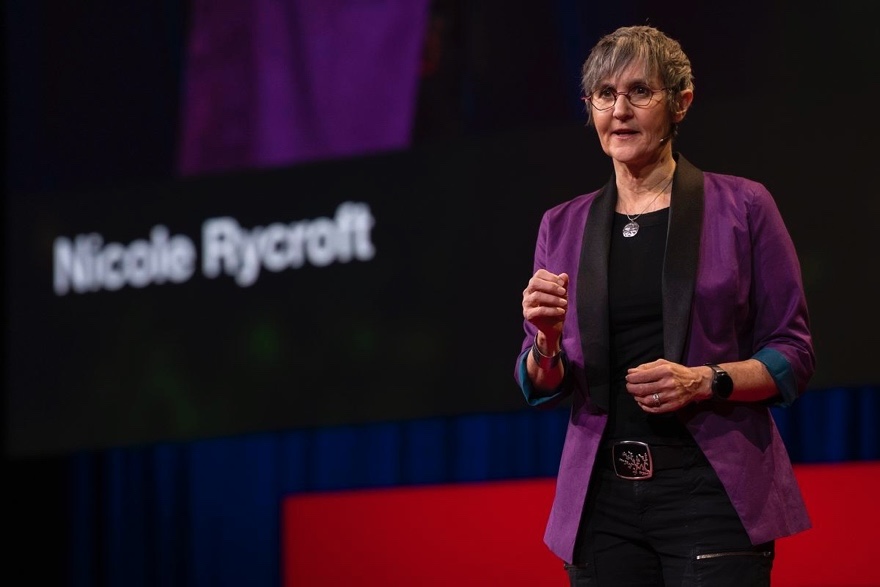
So, what’s stopping more companies from making the switch to waste-based inputs for their packaging, paper and fabrics? Not only is there the cost associated with transitioning away from traditional tree-based inputs, but there is also a need for more transparency in supply chains and more government regulation, Rycroft said.
"The journey to reverse deforestation and forest degradation is deeply rooted in traditional industry practices that rely on ‘take-make-waste’ production systems and powerful entities with deeply vested interests in current production models,” she said. “Our approach at Canopy is to challenge and change current carbon-intensive production by fostering innovative partnerships with leading brands to create the economic incentives for suppliers and governments to change ‘business as usual’ practice.”
Switching to waste-based materials instead of harvesting new ones from the planet’s dwindling supply of forests doesn’t just release less carbon, but it also maintains existing carbon sinks. Each ton of waste-based material eliminates four tons of carbon emissions compared to a ton of material from culled trees, Rycroft said.
But producers have to see the value in evolving, which means there has to be a market reward for them to do so, she said. As such, Canopy is working with brands to scale up in the interest of converting the supply chain from one that relies on processes that are destroying biodiversity and the climate in favor of a sustainable, circular model that puts waste to use instead.
“Keeping forests standing has been consistently identified by economists and scientists as the fastest, cheapest and most effective way to stabilize our climate. Failing to invest in ending deforestation will have far more dire and expensive consequences for our planet and future generations,” Rycroft said. “The cost of inaction goes beyond financial implications. It's about the irreversible damage to biodiversity, the exacerbation of climate change, and the loss of vital ecosystems that are crucial for our survival. Forests are more than just trees —– they are complex ecosystems that are the lungs of our planet, crucial for carbon sequestration and precipitation cycles, and home to countless species.”
The cost of continuing business as usual is too high. Yet the world’s economy is structured in such a way that too many businesses will not do things differently until they are forced by government regulation or, more likely, stand to gain a substantial profit. While it doesn’t make sense to continue cutting down forests to make disposable products when the more sustainable alternative is dumped in landfills year after year, the question is: Will it be possible to scale up this solution in time to stop deforestation before it's too late? In a sense, changing how we make paper, packaging, and certain textiles is a race against the clock to save us from ourselves.
Images courtesy of Canopy
Entrepreneurs of Color Are Less Likely to Turn a Profit. Understanding Why Could Boost the Economy.


(Image: Tim Mossholder/Unsplash)
Starting a business is rarely easy for anyone, but research shows entrepreneurs of color face even more of an uphill climb. In the U.S., entrepreneurs of color are significantly less likely to end their business profitably and many end up losing money, according to a 2023 report from the economic equity nonprofit Prosperity Now.
This is not only devastating for business owners, but it also contributes to a persistent racial wealth gap in which the typical white household has about six times as much wealth as the typical Black household and five times as much as the typical Hispanic household, based on the latest Federal Reserve Survey on Consumer Finance.
“Small businesses owned by people of color can help build intergenerational wealth, but it's only if these businesses are sustainable and profitable,” Doug Ryan, vice president of policy and applied research at Prosperity Now, told TriplePundit. “If they're losing money or they go bankrupt or they fail or they're not able to expand in a meaningful way or be acquired, it's not a sustainable wealth-building strategy for the individual, for the business owner, for the community, or for the country at large.”
In an effort to understand why former entrepreneurs of color walk away from their businesses and to begin to identify potential solutions, Prosperity Now explored a less charted area of entrepreneurship research: the experiences of former business owners.
The data in its Former Entrepreneurs of Color report shines a spotlight on these individuals, revealing unique challenges and systemic barriers they faced. Key findings indicate stark disparities in profit and loss outcomes between white and minority former business owners.
For example, about half of white former entrepreneurs reported a profitable final year of business, and a quarter said they managed to break even. But only around a quarter of Black former entrepreneurs reported profits in their last business year, and another quarter broke even. Among Hispanic former business owners, 38 percent garnered profits in their last business year, while around a quarter reached a break-even point. Additionally, more of the former white business owners sold their enterprise at a profit, whereas more Black and Hispanic entrepreneurs sold their businesses at a loss.
The barriers for entrepreneurs of color
While some of the well-known challenges of being an entrepreneur were evident across all racial and ethnic groups — feeling burnt out and undergoing a significant life event cited as the top reason for closing or ending a business by all former entrepreneurs — the study revealed pronounced disparities by race and ethnicity.
Hispanic former entrepreneurs more frequently attributed business closure to financial challenges, while Black former entrepreneurs more frequently cited operations challenges as a reason for closure.
In addition, Hispanic former entrepreneurs more frequently cited financial challenges as reasons for business closure. Some 95 percent of Hispanic entrepreneurs identified making rent or mortgage payments for their business as a main challenge leading to closure.
Personal finances were the primary financial reason for closing a business across all groups. “How do you address that? I'm not really sure. But what it suggests is that it's really expensive to run a business, and people only have so much appetite for losing money,” Ryan said.
While some of the challenges of owning a business show similarities, no single solution can address them all, Ryan said. “Business owners of color raised some big issues that will not be readily addressed by one type of intervention or another because they are systemic in some ways.”
At a high level, improvements across three structural areas — access to capital, technical assistance and public support — could begin to dismantle some of these barriers, he said.
Expanding access to capital through community development financial institutions
Access to capital to support business operations was a significant barrier for almost all of the Hispanic former entrepreneurs surveyed, as well as 69 percent of Black and 62 percent of white former entrepreneurs.
A potential solution that is currently underleveraged are nonprofit community development financial institutions (CDFIs). These are lenders with a mission to provide fair, responsible financing to rural, urban, Native, and other communities that mainstream finance doesn’t traditionally reach. They serve as critical resources for small businesses in Black and Latinx communities, creating a secondary market for innovative small business lending, Ryan said.
“We have a 25-year-plus history with CDFIs, and building out their capacity to meet the needs of entrepreneurs of color is really important,” he told us. “Because they're nonprofits and they're also community-based, they are positioned differently than other lenders or other financial institutions to provide technical assistance and be the connective tissue with other resources in the community.”
The more than 1,300 certified CDFIs nationwide manage more than $222 billion, much of which they invest locally to create jobs, affordable housing, financial health, and opportunity for their communities — which can be transformational for investing in communities of color, as TriplePundit has reported.
In April 2023, the U.S. Treasury Department awarded $1.73 billion to hundreds of CDFIs to strengthen their ability to help low- and moderate-income communities recover from the COVID-19 pandemic and invest in long-term prosperity. This infusion of funding can help CDFIs scale further “so they can help small business owners, particularly Black and Latino business owners, sustain themselves, become profitable and begin to create intergenerational wealth,” Ryan said.
Tapping into government resources for technical assistance
Black former entrepreneurs more frequently cited business operations challenges, such as navigating government regulations and maintaining business licenses, as a reason for business closure, according to Prosperity Now’s survey. This finding underscores how crucial it is for entrepreneurs of color to get the technical assistance they need.
“From the big-picture perspective, technical assistance and access to capital are absolutely necessary for a small business to succeed. But what are the hurdles to addressing that?” Ryan said.
One welcome development is the decision in 2021 by Congress to codify the Minority Business Development Administration (MBDA) within the Department of Commerce to make it permanent, he said. The MBDA is the only federal agency solely dedicated to the growth and global competitiveness of minority business enterprises. It invests in a national network of MBDA business centers, specialty centers, and grantees, offering customized business development and industry-focused services to provide greater access to capital, contracts and markets.
The Congressional vote to codify this Nixon-era agency matters because “it gives it more heft and, frankly, more of the certainty that businesses and other investors would rely on,” Ryan said. "For example, if you're getting assistance from the MBDA and you are looking for outside investors, it gives investors the confidence that you're going to have the support in the long run because this is now a statutory organization.”
In August, the MBDA announced the Capital Readiness Program, a $125 million technical assistance program to help minority and other underserved entrepreneurs grow and scale their businesses.
“That’s not a lot of money in a $25 trillion economy but it is a lot of money if it is targeted the right way,” Ryan said. “If you couple that with what the MBDA is doing with the business centers, which are effectively incubators, we could really make some progress.”
Strengthening networks can fill critical gap in support
Another key finding was a critical gap in community and professional support that led to business closures among former minority entrepreneurs. Community support deficits led to business closure for 97 percent of Hispanic and 73 percent of Black former business owners, compared to 67 percent of white former entrepreneurs. This illuminates the third structural area to address: strengthening professional networks and other forms of support.
Black and Hispanic entrepreneurs more frequently reported a lack of family support and a lack of access to professional guidance and role models as a reason they had to close their business.
For Ryan, the other two structural gaps — access to capital and technical assistance from either the government or other entities — are tied to this lack of community support.
“If you have a local network within your field or industry, you're more likely to be able to navigate not just the access to capital, but also the technical assistance offered through more formal networks such as local business incubators that could help reduce costs for office or other real estate space, for example,” Ryan said. “Our report shows that when you don't have those resources or those networks to fall back on, it does make those businesses less likely to succeed.”
This support — while undeniably helpful if it comes from professional networks, family or community support — must ultimately come from the government to have an impact at scale, Ryan said.
“Government at all levels has to do a better job in reaching out to underserved communities with the resources they have available — from small business lending, to technical assistance, to incubators, to tax credits, to tax filing assistance, to licensure and much more,” he explained. “We need to take away some of the roadblocks to build out people’s ability to succeed.”
Indeed, when businesses owned by Black and Hispanic entrepreneurs fail, can’t get off the ground, or underperform, it doesn’t just exacerbate the racial wealth gap, but it also has an outsized impact on the U.S. economy. If privately-held, Black-owned businesses had the same revenue averages as white-owned firms, it would pump another $200 billion into the economy, according to a 2020 study by the global management consulting firm McKinsey & Co.